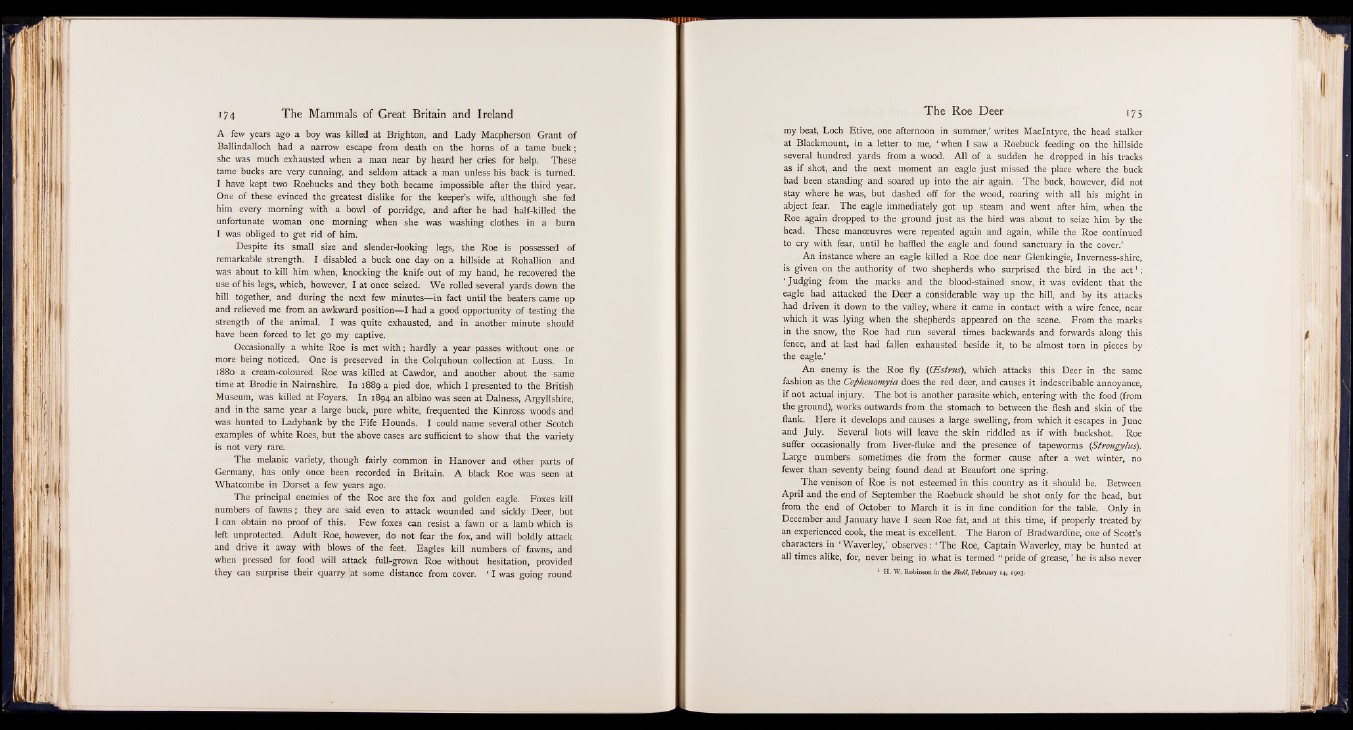
A few years ago a boy was killed at Brighton, and Lady Macpherson Grant of
Ballindalloch had a narrow escape from death on the horns of a tame buck;
she was much exhausted when a man near by heard her cries for help. These
tame bucks are very cunning, and seldom attack a man unless his back is turned.
I have kept two Roebucks and they both became impossible after the third year.
One of these evinced the greatest dislike for the keeper’s wife, although she fed
him every morning with a bowl of porridge, and after he had half-killed the
unfortunate woman one morning when she was washing clothes in a burn
I was obliged to get rid of him.
Despite its small size and slender-looking legs, the Roe is possessed of
remarkable strength. I disabled a buck one day on a hillside at Rohallion and
was about to kill him when, knocking the knife out of my hand, he recovered the
use of his legs, which, however, I at once seized. We rolled several yards down the
hill together, and during the next few minutes— in fact until the beaters came up
and relieved me from an awkward position— I had a good opportunity of testing the
strength of the animal. I was quite exhausted, and in another minute should
have been forced to let go my captive.
Occasionally a white Roe is met with; hardly a year passes without one or
more being noticed. One is preserved in the Colquhoun collection at Luss. In
1880 a cream-coloured Roe was killed at Cawdor, and another about the same
time at Brodie in Nairnshire. In 1889 a pied doe, which I presented to the British
Museum, was killed at Foyers. In 1894 an albino was seen at Dalness, Argyllshire,
and in the same year a large buck, pure white, frequented the Kinross woods and
was hunted to Ladybank by the Fife Hounds. I could name several other Scotch
examples of white Roes, but the above cases are sufficient to show that the variety
is not very rare.
The melanic variety, though fairly common in Hanover and other parts of
Germany, has only once been recorded in Britain. A black Roe was seen at
Whatcombe in Dorset a few years ago.
The principal enemies of the Roe are the fox and golden eagle. Foxes kill
numbers of fawns; they are said even to attack wounded and sickly Deer, but
I can obtain no proof of this. Few foxes can resist a fawn or a lamb which is
left unprotected. Adult Roe, however, do not fear the fox, and will boldly attack
and drive it away with blows of the feet. Eagles kill numbers of fawns, and
when pressed for food will attack full-grown Roe without hesitation, provided
they can surprise their quarry .at some distance from cover. ‘ I was going round
my beat, Loch Etive, one afternoon in summer,’ writes MacIntyre, the head stalker
at Blackmount, in a letter to me, ‘ when I saw a Roebuck feeding on the hillside
several hundred yards from a wood. All of a sudden he dropped in his tracks
as if shot, and the next moment an eagle just missed the place where the buck
had been standing and soared up into the air again. The buck, however, did not
stay where he was, but dashed off for the wood, roaring with all his might in
abject fear. The eagle immediately got up steam and went after him, when the
Roe again dropped to the ground just as the bird was about to seize him by the
head. These manoeuvres were repeated again and again, while the Roe continued
to cry with fear, until he baffled the eagle and found sanctuary in the cover.’
An instance where an eagle killed a Roe doe near Glenkingie, Inverness-shire,
is given on the authority of two shepherds who surprised the bird in the act1 :
‘ Judging from the marks and the blood-stained snow, it was evident that the
eagle had attacked the Deer a considerable way up the hill, and by its attacks
had driven it down to the valley, where it came in contact with a wire fence, near
which it was lying when the shepherds appeared on the scene. From the marks
in the snow, the Roe had run several times backwards and forwards along this
fence, and at last had fallen exhausted beside it, to be almost torn in pieces by
the eagle.’
An enemy is the Roe fly (CEstrus), which attacks this Deer in the same
fashion as the Cephenomyia does the red deer, and causes it indescribable annoyance,
if not actual injury. The bot is another parasite which, entering with the food (from
the ground), works outwards from the stomach to between the flesh and skin of the
flank. Here it develops and causes a large swelling, from which it escapes in June
and July. Several bots will leave the skin riddled as if with buckshot. Roe
suffer occasionally from liver-fluke and the presence of tapeworms (Strongylus).
Large numbers sometimes die from the former cause after a wet winter, no
fewer than seventy being found dead at Beaufort one spring.
The venison of Roe is not esteemed in this country as it should be. Between
April and the end of September the Roebuck should be shot only for the head, but
from the end of October to March it is in fine condition for the table. Only in
December and January have I seen Roe fat, and at this time, if properly treated by
an experienced cook, the meat is excellent. The Baron of Bradwardine, one of Scott’s
characters in ‘ Waverley,’ observes: ‘ The Roe, Captain Waverley, may be hunted at
all times alike, for, never being in what is termed “ pride of grease, ’ he is also never
1 H. W. Robinson in the Field, February 14, 1903.